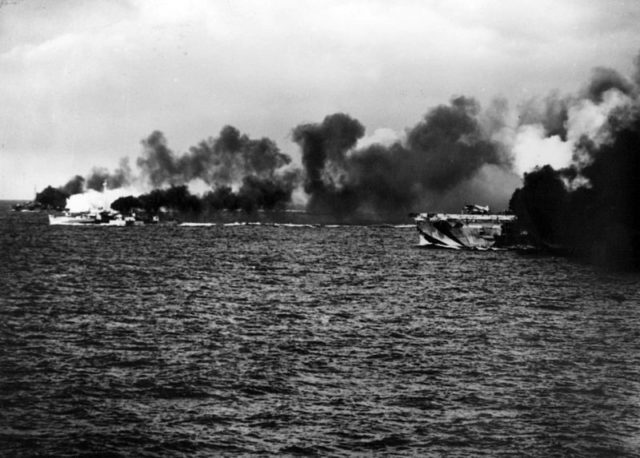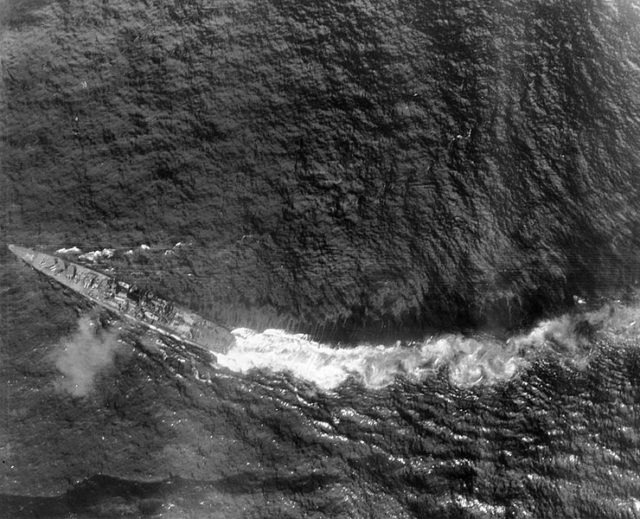USS Samuel B. Roberts had a short-lived but ferocious service. The ship was built in 1944 and was immediately sent to assist the Task Force 77.4.3, nicknamed Taffy 3 in the Pacific Ocean. The ship was named after Coxswain Samuel Booker Roberts, Jr., a Navy Cross recipient.
Roberts was posthumously awarded after he rammed his Higgins landing craft into an enemy vessel, in order to ensure the evacuation of friendly ships during the Battle of Guadalcanal. His heroic act was commemorated by naming this John C. Butler-class destroyer escort after him, but the coxswain’s destiny seems strangely intertwined with the fate of the ship itself.
Like an omen of some sort, the ship encountered a problem on its first day of active service. After spending time at Boston Navy Yard, her port propeller shaft struck a large whale 150 NMI (280 km; 170 mi) off the coast of Maine.
This forced the ship to return for repairs. Finally, in August 1944, USS Samuel B. Roberts joined the Pacific Fleet in Pearl Harbor for training exercises. From there it sailed onwards to join the designated Task Force. USS Samuel B. Roberts finally joined the Taffy 3 and got its first assignment: she was to steam to the Leyte Gulf area near the eastern Philippines, and upon arrival, commence operations with the Northern Air Support Group off the Island of Samar.
![One of the carriers, USS Kitkun Bay prepares to launch her Wildcat fighters; By The original uploader was Nick Dowling at English Wikipedia - This image is available from the Collection Database of the Australian War Memorial under the ID Number: 302773This tag does not indicate the copyright status of the attached work. A normal copyright tag is still required. See Commons:Licensing for more information.Български | English | Français | हिन्दी | Македонски | Português | +/−Transferred from en.wikipedia to Commons.; Sourced from: http://www.awm.gov.au/database/collection.aspCopyright: The AWM record for this photo states that the copyright status is 'clear'. Note: This photo was obviously taken a few minutes before the Official U.S. Navy Photograph (now in the collections of the National Archives) photo no. 80-G-287497 [1], therefore it should be a U.S. Navy photo with a free copyright., Public Domain, https://commons.wikimedia.org/w/index.php?curid=4081750](https://www.warhistoryonline.com/wp-content/uploads/sites/64/2016/09/cve-71_launching_fm-2s_samar_25oct1944-640x537.jpg)
It was the early morning of 25th of October, and the red sun reflected its image on the ocean’s surface. All of a sudden, there were ships behind the sun’s reflection — a 23-vessel-strong task force under the command of Vice Admiral Takeo Kurita — appeared out of nowhere on the horizon and opened fire. Taken by surprise and extremely overpowered, USS Samuel B. Roberts was indeed in a tight spot.
Nevertheless, it decided to charge the Japanese ships without question. The CO, Lieutenant Commander Robert W. Copeland announced to his men:
“We’re making a torpedo run. The outcome is doubtful, but we will do our duty.”
The ship was being heavily fired upon, and a thick smokescreen lingered on the troubled waters. The ship centered its course right towards the Japanese heavy cruiser Chōkai, advancing with piercing speed of 2.5 NMI (4.6 km; 2.9 mi). It was faced with the Chōkai’s forward 8 in (203.2 mm) guns and under direct fire. During the battle, Samuel B. Roberts — designed for 23–24 kn — reached 28.7 kn by diverting all available steam to the ship’s twin turbines.

USS Roberts had moved so close in its ferocious charge, that the enemy guns could not depress enough to hit her and the shells simply passed overhead. Many hit the carrier Gambier Bay, which was trying its best to maneuver for retreat. Once within torpedo range USS Samuel Roberts launched her three Mark 15 torpedoes. One blew off Chōkai’s stern.
The American sailors in an adrenaline rush cheered: “that a way Whitey, we hit ’em.”
It was as if it were a ballgame, as shells were still incoming. USS Samuel B. Roberts then fought with the Japanese ships for a further hour, firing more than six hundred 5 in (127.0 mm) shells, and while maneuvering at very close range, mauling Chōkai’s superstructure with her 40 mm and 20 mm anti-aircraft guns. The Japanese landed two hits on the Roberts, the second of which damaged the aft 5-inch gun.
This damaged gun suffered a breech explosion shortly thereafter which killed and wounded several crew members. With her remaining 5 in (127.0 mm) gun, Roberts set the bridge of the heavy cruiser Chikuma on fire and destroyed the “Number Three” gun turret, before being hit by three 14 in (355.6 mm) shells from the battleship Kongō. The shells tore a hole 40 ft (12.2 m) long and 10 ft (3.0 m) wide on the port side of her aft engine room.

Gunner’s Mate Third Class Paul H. Carr who was in charge of the damaged aft 5 in (127.0 mm) gun mount decided to make the ultimate sacrifice. He had fired nearly all of its 325 stored rounds in 35 minutes before a breech explosion.
Carr was found bleeding at his station from a severe intestinal wound, begging for help to load the last round he was holding into the breech. It was the last he did. The heavy cruiser Chōkai sunk on that day, but so did the Samuel B. Roberts. At 09:35, two hours into the battle, the order was given to abandon ship. She sank 30 minutes later, with 90 of her sailors.

Gunner’s Mate Third Class Paul H. Carr was awarded a Silver Star, and a guided missile frigate was later named for him. The guided missile frigates Copeland and Samuel B. Roberts were also named for the ship and its captain.
The 120 survivors from the ship spent 50 hours out on the open sea, clinging to three life rafts before they were rescued.
The role of the USS Samuel B. Roberts in the Battle of Samar Island inspired generations of Navy servicemen, as the ship truly lived up to its name. For its extraordinary performance and sacrifice, the ship was awarded one Battle Star, and it was mentioned in the Presidental speech given after the battle, as one of the shiniest examples of heroism.
At the U.S. Naval Academy, in Alumni Hall, USS Samuel B. Roberts was referred as the “destroyer escort that fought like a battleship” in the Battle of Leyte Gulf.
